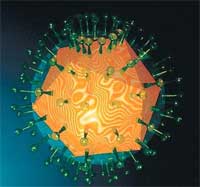Despite significant advancements in understanding the mechanisms of addiction and methods for withdrawal, many individuals relapse within 2-3 months after quitting. Recently, scientists in the United States announced a new discovery regarding the gene responsible for heroin addiction and how to control it.
 |
Herpes Virus |
Dr. Ivan Diamond, a member of the research team at the Ernest Gallo Research and Health Center in the United States, stated: “Many drug addicts have attempted to quit, but after a few months, most of them relapse.”
In 2004, a study revealed that cocaine rapidly activates a gene in the nucleus accumbens known as ANS3, leading to the production of various proteins associated with pleasure and cravings.
Diamond and his research team isolated the AGS3 gene and its protein within the nucleus accumbens of newborn mice. After cloning and studying these cells in the laboratory, researchers identified that the drug-related functions of AGS3 occur within the nucleus accumbens as it interacts with corresponding areas of the cerebral cortex.
A method to control AGS3 was developed using a type of herpes virus. This approach temporarily induces a state of “discomfort” with the reward cycle proteins, effectively blocking the craving cycle until the virus “clears out” of the body over a few weeks.
The drug-addicted mice that had undergone a short withdrawal period exhibited conditioned responses to drugs after receiving the AGS3 control injected into their nucleus accumbens. Subsequently, each mouse was given a small dose of heroin. Typically, the taste of the drug would trigger increased cravings, but the AGS3 control successfully prevented relapse by eliminating the desire.
Diamond told New Scientist magazine that this method could potentially be implemented in humans within the next two years.




















































